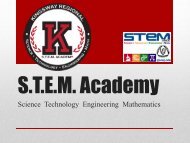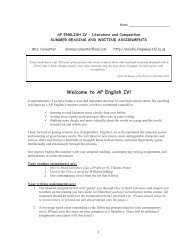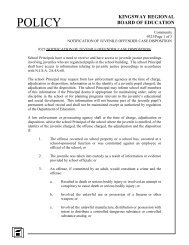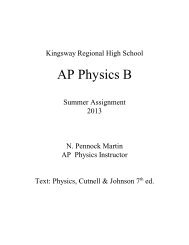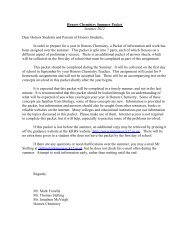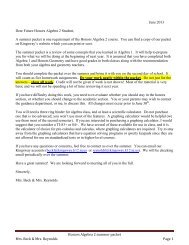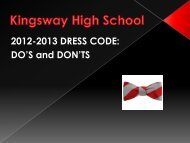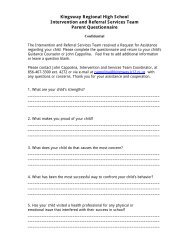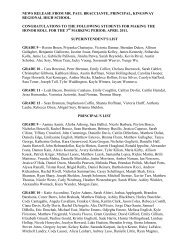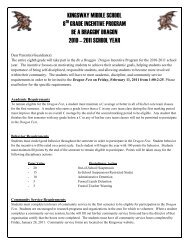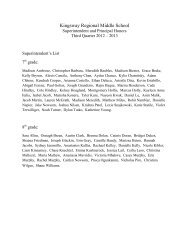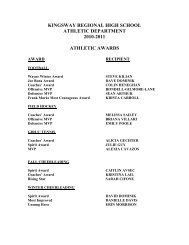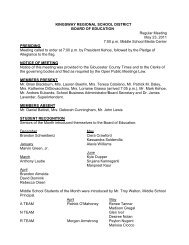Math Webquest 8 - Kingsway Regional School District
Math Webquest 8 - Kingsway Regional School District
Math Webquest 8 - Kingsway Regional School District
You also want an ePaper? Increase the reach of your titles
YUMPU automatically turns print PDFs into web optimized ePapers that Google loves.
KINGSWAY REGIONAL SCHOOL DISTRICT<br />
TITLE OF COURSE:<br />
<strong>Math</strong> <strong>Webquest</strong><br />
CORE CONTENT: <strong>Math</strong>ematics DATE ADOPTED: 02/07<br />
GRADE: 8 DATE REVISED: 08/12<br />
I. COURSE ORGANIZATION<br />
Length: One Year Credits: 0<br />
Periods Per Week: 5 Weighted: No<br />
Prerequisite:<br />
None<br />
II.<br />
COURSE DESCRIPTION<br />
This full year course will strengthen previously taught mathematical concepts as well as those<br />
currently being taught. The topics are aligned with the <strong>Math</strong>ematics Common Core Standards. This<br />
technology-based course will integrate real world mathematical applications. The Internet, Microsoft<br />
Excel, Microsoft Word, and Microsoft PowerPoint will be accessed in order to retrieve and deliver<br />
information.<br />
III.<br />
DISTRICT MISSION<br />
The mission of the <strong>Kingsway</strong> <strong>Regional</strong> <strong>School</strong> <strong>District</strong> is to prepare all students to maximize their<br />
potential as lifelong learners and productive members in a complex society by ensuring the use of an<br />
integrated curriculum including advanced technologies and a broad range of cultural and community<br />
resources. To achieve this mission, the Board of Education, parents, staff, and others work together to<br />
formulate policy, evaluate programs, chart new directions, and implement the best instructional<br />
practices.
<strong>Math</strong> <strong>Webquest</strong> 8 Page 2<br />
IV.<br />
MATHEMATICS MISSION<br />
<strong>Math</strong>ematics education is an integrated, problem-solving experience. The curricula integrate concepts<br />
in mathematics that are essential to decision making, risk-taking, cooperative work, perseverance, selfassessment,<br />
and self-confidence. This instruction will provide students with a variety of skills,<br />
strategies, methods, and materials to assist them in becoming proficient in all areas of mathematics.<br />
Students will learn important mathematical concepts rather that simply memorizing. They will<br />
practice procedures that will enable them to function successfully in their careers and daily lives.<br />
We believe that standards express the desirability of providing all students with opportunities to share<br />
the new vision of mathematics and to learn in ways consistent with it. Students should be encouraged<br />
and enabled to explore, reason logically, draw inferences, and employ a variety of mathematical<br />
methods to become mathematically literate and capable of developing their mathematical power.<br />
V. COURSE LEVEL OUTCOMES<br />
Standards for <strong>Math</strong>ematical Practice<br />
1. Make sense of problems and persevere in solving them.<br />
2. Reason abstractly and quantitatively.<br />
3. Construct viable arguments and critique the reasoning of others.<br />
4. Model with mathematics.<br />
5. Use appropriate tools strategically.<br />
6. Attend to precision.<br />
7. Look for and make use of structure.<br />
8. Look for and express regularity in repeated reasoning.<br />
Standards for <strong>Math</strong>ematical Content<br />
In Grade 8, instructional time should focus on three critical areas: (1) formulating and reasoning about<br />
expressions and equations, including modeling an association in bivariate data with a linear equation, and<br />
solving linear equations and systems of linear equations; (2) grasping the concept of a function and<br />
using functions to describe quantitative relationships; (3) analyzing two- and three-dimensional space and<br />
figures using distance, angle, similarity, and congruence, and understanding and applying the Pythagorean<br />
Theorem.<br />
8.NS1<br />
8.NS2<br />
The Number System<br />
Know that there are numbers that are not rational, and approximate them by rational numbers.<br />
Know that numbers that are not rational are called irrational. Understand informally that<br />
every number has a decimal expansion; for rational numbers show that the decimal expansion<br />
repeats eventually, and convert a decimal expansion, which repeats eventually into a rational<br />
number.<br />
Use rational approximations of irrational numbers to compare the size of irrational numbers,<br />
locate them approximately on a number line diagram, and estimate the value of expressions<br />
(e.g., π 2 ). For example, by truncating the decimal expansion of √2, show that √2 is between<br />
1 and 2, then between 1.4 and 1.5, and explain how to continue on to get better<br />
approximations.
Course Level Outcomes (continued) <strong>Math</strong> <strong>Webquest</strong> 8 Page 3<br />
8.EE1<br />
8.EE2<br />
8.EE3<br />
8.EE4<br />
8.EE5<br />
8.EE6<br />
8.EE7<br />
8.EE8<br />
Expressions and Equations<br />
Work with radicals and integer exponents.<br />
Know and apply the properties of integer exponents to generate equivalent numerical<br />
expressions. For example, 3 2 ×3 –5 = 3 –3 = 1/3 3 = 1/27.<br />
Use square root and cube root symbols to represent solutions to equations of the form x 2 = p and<br />
x 3 = p, where p is a positive rational number. Evaluate square roots of small perfect squares and<br />
cube roots of small perfect cubes. Know that √2 is irrational.<br />
Use numbers expressed in the form of a single digit times an integer power of 10 to estimate very<br />
large or very small quantities, and to express how many times as much one is than the other. For<br />
example, estimate the population of the United States as 3 × 10 8 and the population of the<br />
world as 7 × 10 9 , and determine that the world population is more than 20 times larger.<br />
Perform operations with numbers expressed in scientific notation, including problems where both<br />
decimal and scientific notation are used. Use scientific notation and choose units of appropriate<br />
size for measurements of very large or very small quantities (e.g., use millimeters per year for<br />
seafloor spreading). Interpret scientific notation that has been generated by technology.<br />
Expressions and Equations<br />
Understand the connections between proportional relationships, lines, and linear equations.<br />
Graph proportional relationships, interpreting the unit rate as the slope of the graph. Compare<br />
two different proportional relationships represented in different ways. For example, compare a<br />
distance-time graph to a distance-time equation to determine which of two moving objects<br />
has greater speed.<br />
Use similar triangles to explain why the slope m is the same between any two distinct points on a<br />
non-vertical line in the coordinate plane; derive the equation y = mx for a line through the origin<br />
and the equation y = mx + b for a line intercepting the vertical axis at b.<br />
Expressions and Equations<br />
Analyze and solve linear equations and pairs of simultaneous linear equations.<br />
Solve linear equations in one variable.<br />
Analyze and solve pairs of simultaneous linear equations.<br />
Function<br />
Define, evaluate, and compare functions.<br />
8.F1 Understand that a function is a rule that assigns to each input exactly one output. The graph of a<br />
function is the set of ordered pairs consisting of an input and the corresponding output.<br />
8.F2 Compare properties of two functions each represented in a different way (algebraically, graphically,<br />
numerically in tables, or by verbal descriptions). For example, given a linear function represented<br />
by a table of values and a linear function represented by an algebraic expression, determine<br />
which function has the greater rate of change.<br />
8.F3 Interpret the equation y = mx + b as defining a linear function, whose graph is a straight line; give<br />
examples of functions that are not linear. For example, the function A = s 2 giving the area of a<br />
square as a function of its side length is not linear because its graph contains the points (1,1),<br />
(2,4) and (3,9), which are not on a straight line.<br />
Function<br />
Use functions to model relationships between quantities.<br />
8.F4 Construct a function to model a linear relationship between two quantities. Determine the rate<br />
of change and initial value of the function from a description of a relationship or from two (x, y)<br />
values, including reading these from a table or from a graph. Interpret the rate of change and initial<br />
value of a linear function in terms of the situation it models, and in terms of its graph or a table<br />
of values.
Course Level Outcomes (continued) <strong>Math</strong> <strong>Webquest</strong> 8 Page 4<br />
8.F5 Describe qualitatively the functional relationship between two quantities by analyzing a graph<br />
(e.g., where the function is increasing or decreasing, linear or nonlinear). Sketch a graph that exhibits<br />
the qualitative features of a function that has been described verbally.<br />
Geometry<br />
Understand congruence and similarity using physical models, transparencies, or geometry software.<br />
8.G1 Verify experimentally the properties of rotations, reflections, and translations:<br />
8.G2 Understand that a two-dimensional figure is congruent to another if the second can be obtained from<br />
the first by a sequence of rotations, reflections, and translations; given two congruent figures, describe<br />
a sequence that exhibits the congruence between them.<br />
8.G3 Describe the effect of dilations, translations, rotations, and reflections on two-dimensional figures<br />
using coordinates.<br />
8.G4 Understand that a two-dimensional figure is similar to another if the second can be obtained from the<br />
first by a sequence of rotations, reflections, translations, and dilations; given two similar twodimensional<br />
figures, describe a sequence that exhibits the similarity between them.<br />
8.G5 Use informal arguments to establish facts about the angle sum and exterior angle of triangles,<br />
about the angles created when parallel lines are cut by a transversal, and the angle-angle criterion for<br />
similarity of triangles. For example, arrange three copies of the same triangle so that the sum<br />
of the three angles appears to form a line, and give an argument in terms of transversals why<br />
this is so.<br />
Geometry<br />
Understand and apply the Pythagorean Theorem.<br />
8.G6 Explain a proof of the Pythagorean Theorem and its converse.<br />
8.G7 Apply the Pythagorean Theorem to determine unknown side lengths in right triangles in real-world<br />
and mathematical problems in two and three dimensions.<br />
8.G8 Apply the Pythagorean Theorem to find the distance between two points in a coordinate system.<br />
Geometry<br />
Solve real-life and mathematical problems involving angle measure, area, surface area, and volume.<br />
8.G9 Know the formulas for the volumes of cones, cylinders, and spheres and use them to solve realworld<br />
and mathematical problems.<br />
Statistics and Probability<br />
Investigate patterns of association in bivariate data.<br />
8.SP1 Construct and interpret scatter plots for bivariate measurement data to investigate patterns of<br />
association between two quantities. Describe patterns such as clustering, outliers, positive or negative<br />
association, linear association, and nonlinear association.<br />
8.SP2 Know that straight lines are widely used to model relationships between two quantitative variables.<br />
For scatter plots that suggest a linear association, informally fit a straight line, and informally assess<br />
the model fit by judging the closeness of the data points to the line.<br />
8.SP3 Use the equation of a linear model to solve problems in the context of bivariate measurement data,<br />
interpreting the slope and intercept. For example, in a linear model for a biology experiment,<br />
interpret a slope of 1.5 cm/hr as meaning that an additional hour of sunlight each day is<br />
associated with an additional 1.5 cm in mature plant height.<br />
8.SP4 Understand that patterns of association can also be seen in bivariate categorical data by displaying<br />
frequencies and relative frequencies in a two-way table. Construct and interpret a two-way table<br />
summarizing data on two categorical variables collected from the same subjects. Use relative<br />
frequencies calculated for rows or columns to describe possible association between the two<br />
variables. For example, collect data from students in your class on whether or not they have a<br />
curfew on school nights and whether or not they have a curfew also tend to have chores?
Course Level Outcomes (continued) <strong>Math</strong> <strong>Webquest</strong> 8 Page 5<br />
Cross Content Standards<br />
A. 8.1-Educational Technology: All students will use digital tools to access, manage, evaluate,<br />
and synthesize information in order to solve problems individually and collaboratively and to<br />
create and communicate knowledge.<br />
B. 8.2-Technology Education, Engineering, and Design: All students will develop an<br />
understanding of the nature and impact of technology, engineering, technological design, and<br />
the designed world, as they relate to the individual, global society, and the environment.<br />
C. 9.1-21st-Century Life and Career Skills: All students will demonstrate the creative, critical<br />
thinking, collaboration, and problem-solving skills needed to function successfully as both<br />
global citizens and workers in diverse ethnic and organizational cultures.<br />
D. 9.3-Career Awareness, Exploration, and Preparation: All students will apply knowledge<br />
about and engage in the process of career awareness, exploration, and preparation in order to<br />
navigate the globally competitive work environment of the information age.<br />
VI.<br />
COURSE LEVEL ASSESSMENTS<br />
Students are evaluated regularly through a variety of procedures. During instruction, teachers use<br />
varied questioning techniques to monitor student behavior and check for understanding. Written<br />
assignments are part of the ongoing assessment program. The teacher-made tests and/or textbookrecommended<br />
tests are given at regular intervals. All assessments will be under the discretion of the<br />
individual teacher.<br />
VII. POSSIBLE ASSESSMENT TASKS<br />
Methods to be utilized may include, but are not limited to the following:<br />
Traditional tests and quizzes<br />
Monitoring<br />
Response/oral presentations<br />
Cooperative Learning Activities<br />
Open-ended and free response questioning Journal writing<br />
Projects/Reports<br />
Models<br />
Lab Activities<br />
Charts and graphs<br />
Peer Checking<br />
VIII. CONTENT/SUGGESTED INSTRUCTIONAL TIME<br />
Quarter One<br />
A. Technology (Ongoing)<br />
1. Use of computers<br />
2. Use of calculators<br />
3. Use of Internet<br />
4. Use of PowerPoint<br />
5. Use of Excel<br />
6. Use of Microsoft Word
Content/Suggested Instructional Time (continued) <strong>Math</strong> <strong>Webquest</strong> 8 Page 6<br />
Concepts:<br />
Technology is a crucial skill in today’s world.<br />
Technology provides another outlet in which to learn.<br />
B. Variables, Expressions, and Properties (5 weeks)<br />
1. Integers and absolute value<br />
2. The four basic operations with integers<br />
3. Real number properties (commutative, associative, distributive, additive and multiplicative<br />
identities, and additive and multiplicative inverses)<br />
4. Square roots (finding square roots of perfect squares and estimating)<br />
5. Powers and exponents<br />
6. Solve word problems that involve variables and expressions<br />
Concepts:<br />
Number sense is essential in all areas of mathematics.<br />
C. Rational Numbers (4 weeks)<br />
1. Identification of rational and irrational numbers, prime and composite numbers<br />
2. Find the prime factorization of a composite number<br />
3. Greatest Common Factor (GCF)<br />
4. Least Common Multiple (LCM)<br />
5. Introduction of the fraction as a single number (not broken down as numerator and<br />
denominator)<br />
6. Modeling Simplified Fractions<br />
7. Operations with Fractions: Students should understand the whys in addition to the<br />
methods used—The four basic operations with fractions will also include adding like and<br />
unlike, subtracting like and unlike with concern for regrouping, multiplying and dividing<br />
fractions, improper fractions, and mixed numbers.<br />
8. Solve word problems that involve rational numbers<br />
Concepts:<br />
Fractions are basic mathematical concepts integral to algebraic understanding.<br />
GCFs and LCMs put number theory into practice.<br />
Quarter Two<br />
A. Proportional Reasoning (4 weeks)<br />
1. Identify ratios and rates<br />
2. Rate of change<br />
3. Solving proportions<br />
4. Set up proportions from word problems and solve<br />
5. Scale drawings<br />
6. Convert between fractions, decimals, and percents<br />
7. Ratios and percents (revisit fractions)<br />
8. Solve word problems involving proportional reasoning<br />
Concepts:<br />
Fractions, decimals, and percents are basic mathematical concepts.<br />
Proportions and percents are practical to everyday life.<br />
Word problems involving proportional reasoning reflect real-world scenarios.
Content/Suggested Instructional Time (continued) <strong>Math</strong> <strong>Webquest</strong> 8 Page 7<br />
B. Equations (5 weeks)<br />
1. Solve one-step equations<br />
2. Solve two-step equations<br />
3. Solve multi-step equations<br />
4. Solve equations with variables on both sides<br />
5. Solve word problems involving multi-step equations<br />
Concepts:<br />
The solving of equations is a principle concept of algebra.<br />
Quarter Three<br />
A. Geometry (3 weeks)<br />
1. Line and angle relationships<br />
2. Triangles and angles<br />
3. Pythagorean theorem<br />
4. Slope (distance on a coordinate plane)<br />
5. Transformations (reflections, translations, rotations, and dilations)<br />
Concepts:<br />
Geometry enables the mathematics to move from the abstract to the concrete.<br />
Formulas provide a hands-on crossover from the algebra to real-world situations.<br />
The utilization of formulas encourages cross-curricular ties.<br />
B. Geometry: Area and Volume (3 weeks)<br />
1. Area of polygons (parallelograms, triangles, and trapezoids)<br />
2. Circumference and area of circles<br />
3. Area of complex figures<br />
4. Area of three dimensional figures<br />
5. Volume of prisms and cylinders<br />
6. Volume of pyramids and cones<br />
7. Surface area of prisms, cylinders, pyramids, and cones<br />
Concepts:<br />
Geometry enables mathematics to move from the abstract to the concrete.<br />
Formulas provide a hands-on crossover from the algebra to real-world situations.<br />
The utilization of formulas encourages cross-curricular ties.<br />
Technology provides an outlet in which to learn.<br />
C. Probability (3 weeks)<br />
1. Probability of simple and compound events<br />
2. Differentiate between dependent and independent events<br />
3. Counting outcomes<br />
4. Permutations<br />
5. Combinations<br />
6. Solve word problems involving probability<br />
Concepts:<br />
Determining the probability of an event aids in better decision-making.<br />
<br />
<br />
Technology provides an outlet in which to learn.<br />
Creating probability scenarios in the form of a PowerPoint project allows the students to<br />
synthesize the material.
Content/Suggested Instructional Time (continued) <strong>Math</strong> <strong>Webquest</strong> 8 Page 8<br />
Quarter Four<br />
A. Statistics (3 weeks)<br />
1. Displays of data<br />
2. Histograms<br />
3. Circle graph<br />
4. Choosing appropriate displays of data<br />
5. Measures of central tendency<br />
6. Solve word problems involving statistics<br />
Concepts:<br />
Comprehension of displays of data is a real-life application of statistics, e.g. newspapers,<br />
periodicals, and community information<br />
B. Algebra (3 weeks)<br />
1. Simplifying algebraic expressions<br />
2. Writing two-step equations (one-step and multi-step with variables on one or both sides)<br />
3. Introduction of inequalities<br />
4. Solving inequalities by adding/subtracting/multiplying/dividing<br />
5. Solve word problems involving inequalities<br />
Concepts:<br />
The solving of equations is a principle concept of algebra.<br />
C. Linear Functions (3 weeks)<br />
1. Plot points in a coordinate plane<br />
2. Graph a line in the coordinate plane<br />
3. Graph linear functions<br />
4. Slope formula: determine slope of a line utilizing the change in y divided by change in x.<br />
5. Slope intercept formula (y = mx + b)<br />
6. Graphing systems of equations<br />
7. Graphing linear inequalities<br />
Concepts:<br />
Equations are a key concept in Algebra; systems of equations provide an example of what<br />
two lines can do in a plane.
<strong>Math</strong> <strong>Webquest</strong> 8 Page 9<br />
IX.<br />
MODIFICATIONS: INCLUSION TECHNIQUES/ENRICHMENTS<br />
Possible instructional techniques may include but may not be limited to the following:<br />
Resource Center—A course of study will be modified to accommodate the specific needs of a<br />
special education student as outlined in his/her IEP.<br />
Inclusion—Peer tutoring, computer software, oral tests, visual organizers, study guides, and<br />
cooperative learning activities<br />
Enrichments—Field trips, guest speakers, brochure design, simulations, drama, and poetry<br />
Students are provided with a basic text and/or supplemental curricular materials that are used for<br />
assigned readings, discussion, and information gathering. Through teacher-directed instructional<br />
activities, students are asked to acquire knowledge, develop an understanding of content, apply<br />
information to their own lives, analyze data, synthesize material, and make evaluative judgments.<br />
When planning each lesson, teachers select specific objectives, organize material to achieve maximum<br />
understanding, make associations, and check for understanding at frequent intervals. Technology<br />
materials are used when appropriate. Suggestions for specific assignments and student activities are<br />
found in the teacher’s resource guide of the approved textbook series.<br />
X. INTERDISCIPLINARY CONNECTIONS/MULTICULTURAL MATERIALS<br />
Visual and Performing Arts<br />
PowerPoint project<br />
Health/Physical Education<br />
<strong>Math</strong>ematics<br />
<strong>Webquest</strong>s<br />
Various shared concepts<br />
Science<br />
Application of formulas<br />
Data collection<br />
Organization of data<br />
Social Studies<br />
<strong>Math</strong> in History<br />
World Languages<br />
21 st Century Life and Careers<br />
Use of computers and<br />
calculators<br />
Language Arts Literacy<br />
<strong>Math</strong> vocabulary<br />
Word problem<br />
comprehension<br />
Technology<br />
Computers/Internet<br />
Calculators<br />
XI.<br />
MATERIALS/TECHNOLOGY<br />
A. Computers<br />
B. Calculators<br />
C. Software<br />
D. Internet<br />
E. Games/manipulatives



